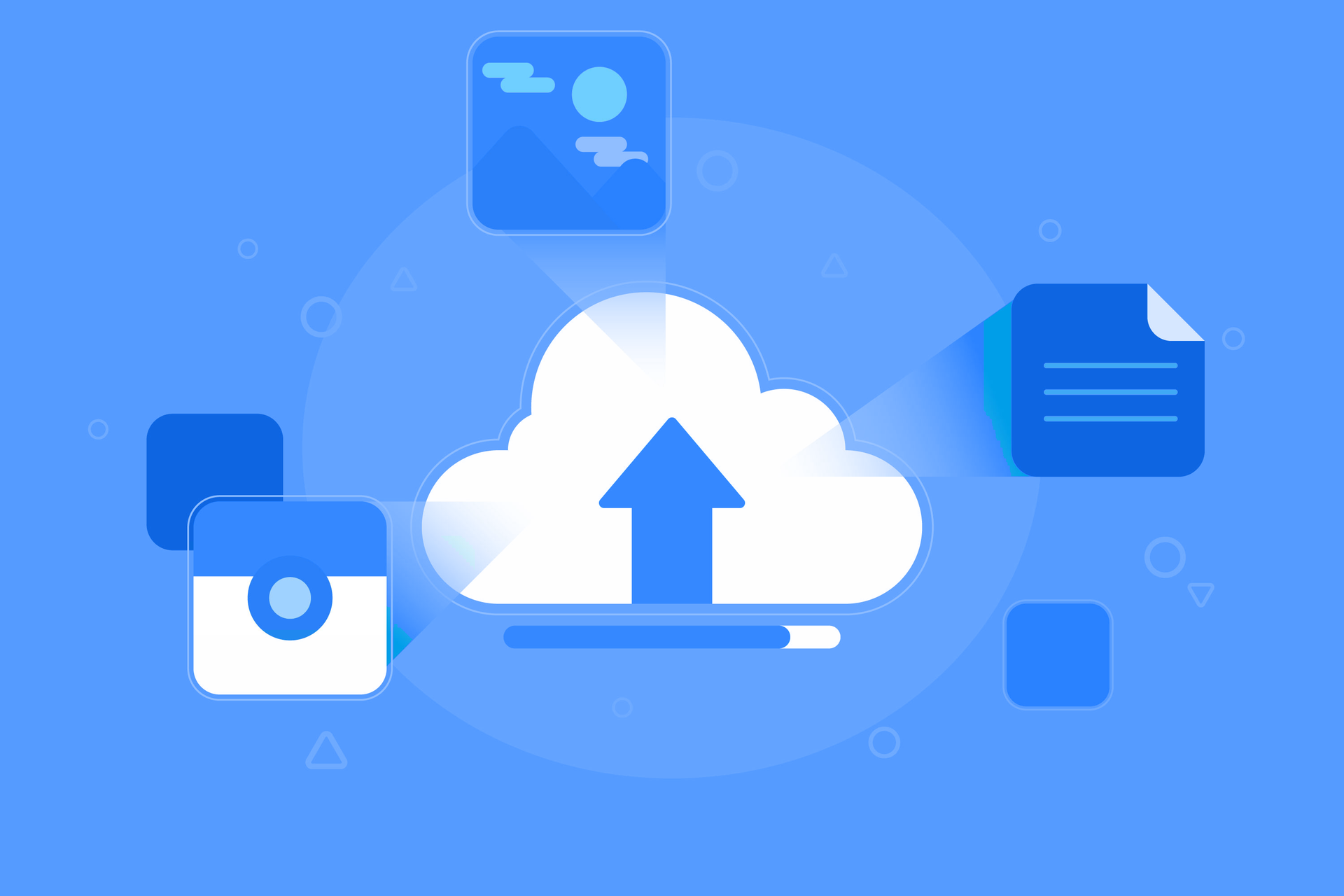How to Choose the Right Cloud Storage for Your Small Business

Selecting the best cloud storage solution can be similar to being faced with an endless buffet of options, each one claiming to be the best. A poor choice may result in lost revenue, compromised data, or even a snag in productivity. The stakes are extremely high for small business owners.
Regardless of your level of experience, we will guide you through this thorough guide to help you choose a cloud storage solution that is specific to your company's needs.
Why Should Small Businesses Consider the Right Cloud Storage?
Digital transformation has taken place in business operations. Cloud storage has become essential due to remote work, mobile-first communication, and the rapid accumulation of data. It is the foundation of resilience and efficiency.
After moving to the cloud,
94% of businesses reported significant security improvements, according to a TechRepublic report. That figure says everything. Every little bit of operational improvement matters for small businesses.
Here are some key benefits that drive cloud storage adoption:
• Cost-efficiency - Pay only for what you use, with no need for bulky servers.
• Built-in security - Most providers offer encryption, permissions controls, and auditing tools.
• Scalability - Add or reduce storage space on demand without purchasing new hardware.
• Remote collaboration - Access files securely from anywhere, on any device.
In short, cloud storage enables small businesses to compete with larger organizations by offering enterprise-level tools without the enterprise-level price tag.
Choosing the Right Cloud Storage for Your Small Business
The methodology and implementation of password spraying set it apart from other brute-force attacks. Password spraying uses a single password across several accounts, whereas traditional brute-force attacks concentrate on trying multiple passwords against a single account. Because of this distinction, attackers are able to evade activating account lockout policies, which are intended to prevent an excessive number of login attempts on a single account.
Know Your Storage Needs
Understand What You're Storing
Prioritize the data that your company truly needs before selecting a storage solution. Not all images or documents require long-term storage. While some files are retained for compliance or historical reasons, other data is mission-critical and used on a daily basis.
Ask yourself:
· How much total data are we currently storing?
· What portion of that is active, and what's archival?
· How fast is our data growing and why?
Doing a basic data inventory helps prevent overpaying for unused storage space while ensuring you don't run out of room when it matters most.
Consider File Types and Use Cases
The storage needs of various industries vary greatly. For example, a small law firm primarily deals with text files and PDFs, which are smaller and require less storage space. A marketing agency or architectural firm, on the other hand, works with large media files that can rapidly increase storage requirements.
Selecting a plan with the appropriate performance and capacity features will be easier if you are aware of the particular file types and workflows you use.
Evaluate Your Budget
Don't Just Look at Monthly Costs
Even though it might be alluring to look for the best monthly deal, many cloud storage options have variable or hidden fees. These may surprise you, particularly if your needs for data storage change over time.
Watch out for:
· Extra fees for large data transfers
· Premium charges for faster access or retrieval
· Security add-ons or compliance upgrades
Think in terms of total cost of ownership rather than just a monthly bill. The cheapest plan could end up costing more if it doesn't meet your actual needs.
Pay-as-You-Go vs. Fixed Plans
Pay-as-you-go pricing might be the best option for your company if you deal with seasonal variations or erratic data usage. These models are adaptable and typically grounded in real-world usage.
A set monthly plan, on the other hand, might provide you with peace of mind and aid in budgeting if you value cost predictability and are certain that your data storage requirements are constant. Before making a commitment, think about comparing prices based on your data requirements over the previous six to twelve months.
Prioritize Security and Compliance
Not only big businesses are concerned about cyber threats. According to Wired, small businesses are the target of 43% of cyberattacks. Data breaches, monetary losses, or even legal action may result from these attacks.
Choosing a secure cloud provider is crucial. Look for the following features:
· End-to-end encryption, covering data at rest and in transit
· Multi-factor authentication (MFA) for user accounts
· Automatic backups and disaster recovery protocols
· Compliance certifications like GDPR, HIPAA, or ISO 27001
If your business handles sensitive customer information or falls under data privacy laws, make sure your provider is compliant with relevant regulations.
Make Sure They Have Your Back
Great technology means nothing if support is lacking. Check whether your cloud provider offers:
• 24/7 technical support via chat, email, or phone
• Clear service-level agreements (SLAs) that guarantee uptime and response times
• Disaster recovery support in case of hardware failure or ransomware
When problems arise (and they will) responsive support can make the difference between a minor hiccup and a full-blown crisis.
Think About Scalability
Today's Needs vs. Tomorrow's Growth
A lot of small businesses base their plan on their present requirements, but what happens if their company expands or their storage needs increase?
Scalability should therefore be a given in your cloud strategy. Seek out suppliers who make it simple to:
· Upgrade your storage capacity without major disruption
· Add new users or teams as your company expands
· Access advanced services like automated workflows, AI file tagging, or analytics tools
Scalability isn't just adding more space. It's about building a storage ecosystem that adapts as your business evolves.
Don't Overlook Usability and Integration
How Easy Is It to Use?
Cloud storage should make life easier, not harder. If your team struggles to navigate the interface, productivity can suffer. Look for features like:
• Drag-and-drop uploads
• Ability to sync folders across devices
• User-friendly mobile apps
A clean, intuitive interface will reduce the learning curve and increase adoption across your organization.
Will It Play Nice with Other Tools?
Seamless integration is key. Your cloud solution should work well with your existing software stack. Most businesses benefit from storage that integrates with:
· Microsoft 365 or Google Workspace
· Customer Relationship Management (CRM) systems
· Project management tools like Asana, Trello, or Monday.com
Most providers offer free trials or demos. Involve your team in testing a few platforms to see what works best before making a final decision.
Compare Popular Providers
Google Drive
For companies that value affordability and teamwork, Google Drive is a great option. It is a preferred choice for teams already operating within the Google ecosystem due to its smooth integration with Google Workspace tools like Docs, Sheets, and Gmail. It's a good choice for startups and small teams that need to remain flexible because of its generous free storage tiers and affordable upgrade options.
Dropbox
When ease of use and media storage are your top priorities, Dropbox excels. Dropbox is well-known for its intuitive user interface, which makes sharing and syncing files simple. Because of its strong version control and recovery capabilities and exceptional ability to handle large media files, it is a favorite among creative professionals such as marketers and designers.
OneDrive
For companies that are heavily reliant on Microsoft, OneDrive is perfect. OneDrive is integrated with Word, Excel, and Teams if you're already using Office 365. It offers a seamless, recognizable experience across devices and is especially well-suited for Windows users, particularly in hybrid work environments.
Box
Box is a wise choice for companies in regulated sectors like healthcare, finance, or legal services because of its emphasis on security and compliance. It provides comprehensive permission settings, cutting-edge encryption, and compliance with important frameworks like GDPR and HIPAA. Box gives businesses that deal with sensitive data the assurance that their data is secure.
Every one of these platforms has advantages. Your particular priorities—whether they be teamwork, usability, integration, or unwavering security—will determine which is best for your company.
Common Pitfalls When Choosing the Right Cloud Storage for Your Small Business (And How to Avoid Them)
On the surface, choosing cloud storage may seem straightforward (upload, store, and access), but many small businesses make mistakes that can result in significant inefficiencies, lost data, or unforeseen expenses. The following are the most typical pitfalls and how to avoid them:
Ignoring Security and Compliance Requirements
A lot of small businesses believe that the security of cloud storage platforms is the same. As a result, private client or company information is kept on platforms that don't adhere to industry compliance guidelines or have strong security features like end-to-end encryption.
Always check a provider's data encryption techniques and security certifications (such as ISO 27001 and SOC 2). Make sure the provider complies with your compliance requirements (HIPAA, GDPR, etc.) if you work in a regulated sector like healthcare or finance. Never be afraid to question vendors about their incident response strategy and history of data breaches.
Choosing Based on Price Alone
Choosing the least expensive option may seem like a good idea, but low-cost providers frequently compromise on scalability, uptime reliability, and customer support. Additionally, you might run into unstated costs when transferring data or going over storage limits.
Examine more than just the price. Compare features, customer service, and the capacity to expand with your company to costs. Examine the fine print regarding data transfer costs and pricing tiers. Paying a little bit more for a platform that will actually fulfill your needs is worthwhile.
Overlooking Integration with Existing Tools
Some companies select storage solutions that are incompatible with their current software. Time wastage, redundant work, and annoying workarounds could result from this.
Make sure the cloud storage option works well with the systems you already have, such as Google Workspace, Microsoft 365, QuickBooks, or your CRM. Use the integration directories and app marketplaces that many platforms provide as a resource before making a commitment.
Underestimating Scalability Needs
Some small businesses lock themselves into platforms that aren't designed to scale effectively because they underestimate how quickly their storage needs will increase. If the provider is unable to keep up, an unexpected increase in storage requirements may cause problems.
Select a solution that will expand with you. Look for storage providers that provide enterprise, tiered storage, and flexible plans, even if you have a small team today.
Neglecting Backup and Redundancy
Cloud storage does not imply that data is backed up. Data loss from inadvertent deletion or system malfunctions is still possible in the absence of redundancy or a well-defined backup strategy.
Seek out suppliers who have redundancy and backup built in. Inquire about their approach to data replication; your data ought to be kept in several places. A 3-2-1 backup strategy should also be taken into consideration, which consists of three copies of your data, two different kinds of storage, and one offsite location (which could be the cloud).
Choosing the best cloud storage solution isn't about getting a good deal or choosing a well-known brand. Finding a system that supports your team, fits into your workflow, and provides you with peace of mind is the key. Audit your data requirements first, then select a cost model that works for you.
Do you need help navigating the world of cloud storage? Reach out to us today for advice, implementation support, or to discuss tailored solutions that align with your goals.
Article used with permission from The Technology Press.










